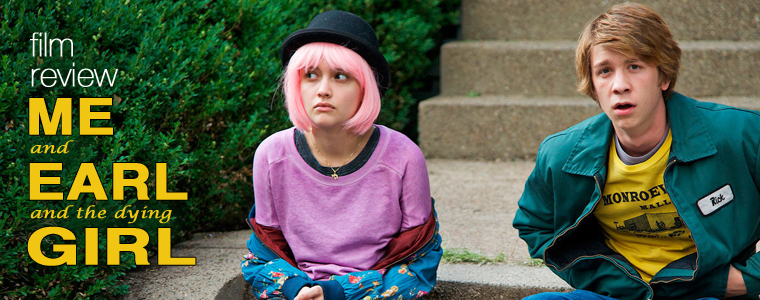Spark in the Darkness
by Andrew Collins
If there’s any sort of literary progression from A Walk to Remember to The Fault in our Stars, director Alfonso Gomez-Rejon’s Me and Earl and the Dying Girl represents the next stage of stories about a young woman who gets cancer.
It’s one of the best films in the category to date because it is the cancer movie this generation deserves. Where author John Green’s piercing novel (and its film adaptation) struck an emotional chord with disillusioned young readers as an existential tear-jerker told by a decaying child-philosopher, Me and Earl and the Dying Girl is filled with characters a little more representative of today’s youth: detached, ambivalent and emotionally isolated.
Oh, and Gomez-Rejon wants you to know that his movie is definitely not a tear-jerker, because that’s an insulting label to give a film.
The “me” in the film’s title is Greg (Thomas Mann), a teenager whose aim in life is to exist as a sort-of-but-not-really member of the various high school “kingdoms” – nerds, jocks, Goths, and so on. This keeps him from making enemies, but it also means he doesn’t have any true friends. The story is told from Greg’s perspective, and he occasionally interjects with deadpan narration to guide the plot. “Earl” (RJ Cyler) is the closest thing Greg has to a friend – a blunt, trash-talking black kid from the wrong side of the tracks who Greg refers to as a “colleague” because they make terrible parodies of classic foreign art films together. The “dying girl” is Rachel (Olivia Cooke), who is diagnosed with leukemia at the beginning of the film. Greg’s mom guilt trips him into hanging out with Rachel because she has cancer, and so begins the story.
One can imagine where the plot should go from there: Greg and Rachel form an unlikely friendship and eventually fall passionately in love before she tragically and heroically dies. But narrator Greg pushes against sentimentality at every turn, interjecting repeatedly that this is not the case. They don’t fall in love, he tells the audience, and she doesn’t die in the end.
The filmmaking antics of Greg and Earl create a delightful background aesthetic for the film – something like a modern, suburban Hugo, with a dash of Wes Anderson. The pair’s lunch-money parodies represent an ode to masterpieces of art cinema, which have their own peculiar power over audiences even when the viewer (an adolescent Greg or Earl, for example) has no idea what’s going on. As Greg wrestles with his first real-life tragedy, we see in him the origins of the creative filmmaker, the raw storyteller concerned less by style and form than the guttural need to express himself. Greg doesn’t know why he made 42 crappy parody films, he just does. He has nothing else to do, and so he lingers as a directionless artist, numbed by regret, a mess of dying potential.
For the several months over which the film takes place, however, Greg’s void of a life is filled by a dying girl. As he gamely tries to pass the time with Rachel, something stirs, unsummoned and unperceived, in his heart. He takes the first tentative steps outside his own barriers of detachment, and everything changes.
But I repeat: don’t break out the tissues. It takes a lot of awkwardness, dark humor, and sexual tension to get to this point of personal transformation. Greg and Earl’s bizarre world of adolescence – with its accidental drug trips, mildly pedophilic mothers, tatted-up history teachers, and unobtainable pretty girls – sustains the film’s spirit as it charts a delicate course between heart and comedy.
After the laughter subsides, however, Me and Earl and the Dying Girl still cares deeply for the stories of its characters. By skirting the romance we all inevitably expect, it lends dignity rather than clichés to the friendship between Greg and Rachel, showing us how the relationships that truly transform us don’t emerge from the fireworks of romantic passion. As Greg learns, the character growth that really counts for something only comes through the much more arduous road of honesty, sacrifice, and faithfulness that destroys self-pity rather than merely escaping it.
In spite of its immature moments and anti-mushiness, something quite beautiful emerges out of Me and Earl and the Dying Girl. In the end, it isn’t the dying girl who really needs life; it’s the boy who had never started to live.








